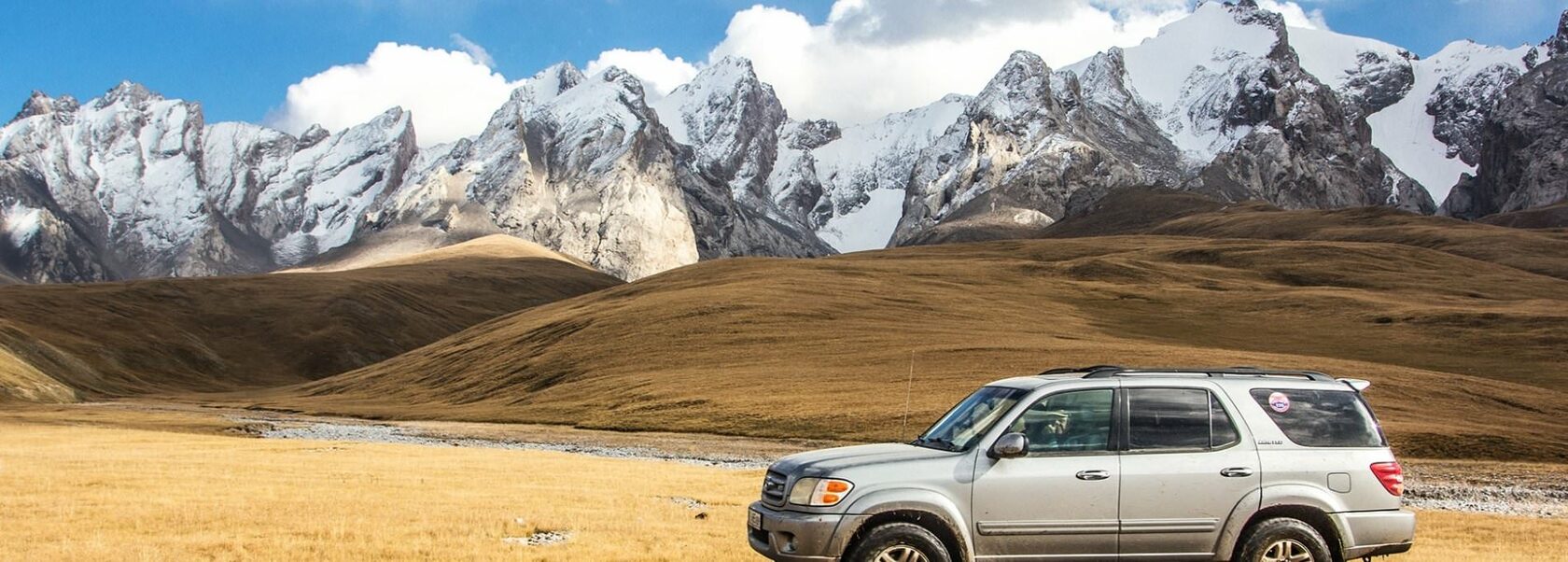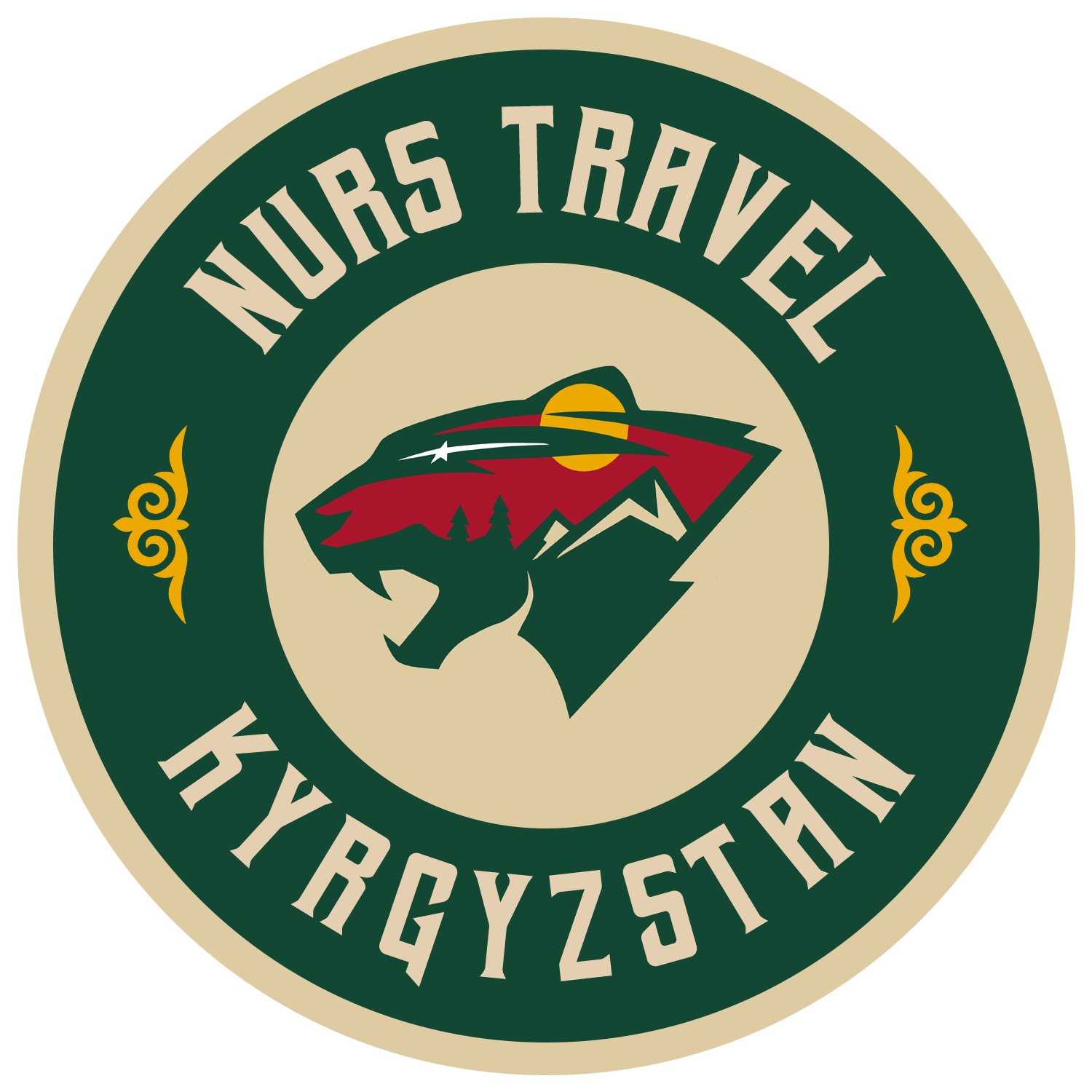

About Kyrgyzstan
- When traveling through the country, you can feel connected to nature and yearning for a simpler life.
- Kyrgyzstan, a fabulous Central Asian country, is very popular with tourists and still shows great tourism potential. It has a long and eventful history and boasts a number of unique heritage sites dating from various times, including the era of the Silk Road caravan tracks, which once ran though its today's territory; and it is of course a country of fascinating natural sites, a grandiose mountain kingdom often referred to as "Central Asian Switzerland"
- The Tien Shan system of mountain ranges covers 80% of its area, featuring the extremely high mountains Pobeda Peak (7,439m), Lenin Peak (7,134m) and Khan-Tengri Peak (6,995m). Lovers of mountaineering, trekking, downhill skiing, snowboarding and other adventure tourism activities regard Kyrgyzstan as one of the world's best vacation destinations.
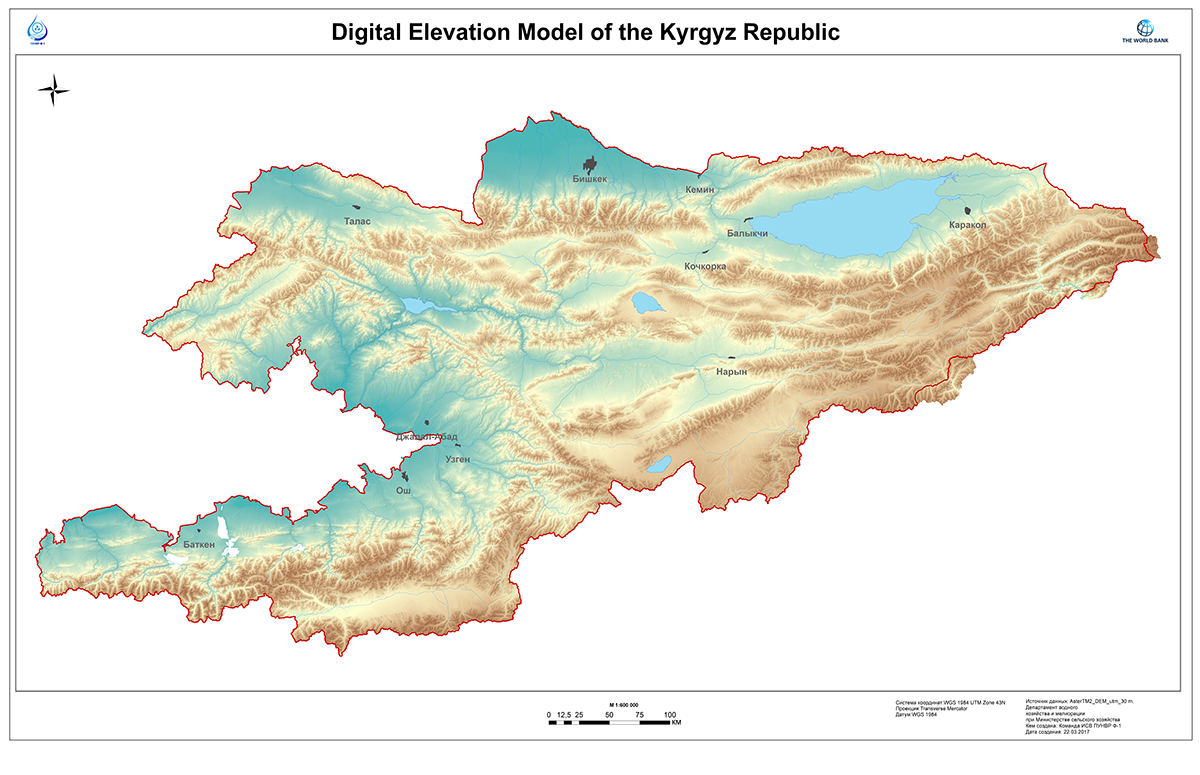
General Information
Kyrgyzstan is a landlocked country in the northeast of the former Soviet Central Asia. It borders China, Kazakhstan, Tajikistan and Uzbekistan. Most of the territory is covered with the Tien Shan mountain ranges. The country's highest mountain is Pobeda Peak (7,439m; "Victory Peak" in Russian; Kyrgyz: Jengish Chokusu); the lowest parts lie at an altitude of about 400 meters. The area is 199,900 square kilometers - five times as large as Switzerland.
Population
The country's population is a little over 5.6 million. Since life is hard in the mountains, most of the people live in the valleys. The largest ethnic group are Kyrgyz. They make up 72% of the population (2013 estimate) and are spread throughout the country. The largest ethnic minorities are Uzbeks (14.5%) concentrated in the south and Russians (9.0%) living mainly in the north. There are also Dungans (1.9%), Uighurs (1.1%), Tajiks (1.1%), Kazakhs (0.7%), Ukrainians (0.5%) and other smaller ethnic minorities, including Germans.
Population
The country's population is a little over 5.6 million. Since life is hard in the mountains, most of the people live in the valleys. The largest ethnic group are Kyrgyz. They make up 72% of the population (2013 estimate) and are spread throughout the country. The largest ethnic minorities are Uzbeks (14.5%) concentrated in the south and Russians (9.0%) living mainly in the north. There are also Dungans (1.9%), Uighurs (1.1%), Tajiks (1.1%), Kazakhs (0.7%), Ukrainians (0.5%) and other smaller ethnic minorities, including Germans.
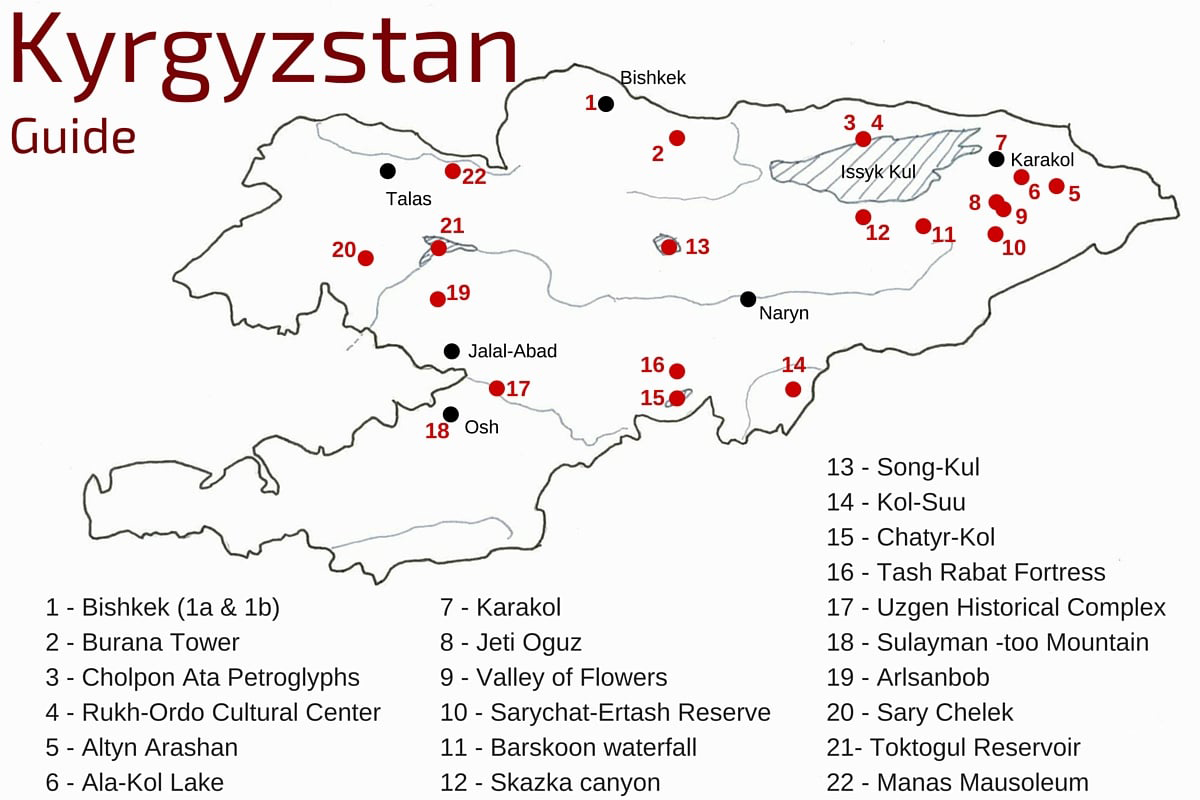
Destination Map
- On routes you will see colorful canyons, as if from films about the Wild West, and red rocks of bizarre shapes, mountains covered with dark green Tien Shan fir-trees with candles, clear sonorous rivers and green meadows, high plateaus with Mongolian landscapes and pastures on Son-Kul Lake, where nomads live.
- Most of the routes will pass through the gorges of both banks of Issyk-Kul, you will visit the most beautiful places.
- And of course, Kyrgyzstan is a nomad! Yurts, felt, herds, riders. Here you can not only see it with your own eyes, but even try a little on yourself, spending the night in a real yurt somewhere in an amazing place and chatting with these interesting people, see how they make felt or race on a horse in their nomadic games .

Climate in Kyrgyzstan
- The country's terrain and location will allow for experiencing almost all types of climate: seaside, subtropical, temperate, dry continental, and even subpolar. The temperatures vary as to region.
- In winter, it is around -8°C in the lowlands and around -27°C in the mountains.
- In summer, however, the temperature is almost the same in the highlands and lowlands - it is around +26°C, with up to +40°C around the southern city of Osh, Fergana Valley, and -10°C around the highest mountain peaks.
- The temperatures around Issyk-Kul Lake do not vary significantly by season and are quite comfortable: it is around +2°C in winter (The lake does not freeze in winter, which even its name meaning "hot lake" is indicative of.) and +18-25°C in summer.
- The precipitation varies from 2,000mm per year in the mountains to around 100mm per year on the west bank of Issyk-Kul Lake. The air in the country is mainly dry. The yearly number of sunny days is quite large - it is 247.

How to dress
- The best summer clothes to wear in the country will be T-shirts, light shirts, light and loose trousers, shorts, or sundresses. Clothes made of cotton, or having most of cotton, will feel ideal - cotton breathes and absorbs sweat better than synthetics. Do not forget that white garments will take less solar heat. However, the humidity is low in Kyrgyzstan, so high temperatures are quite bearable unless you are in the south of the country in mid-summer.
- Remember that your footwear must be comfortable, light and strong, since you will have to walk over rough ground surfaces at times. Light sandals will be great to wear in the cities. Sunglasses, light headwear and sunblock lotion should also be kept handy in summer.
- There are no dressing style limits in the local culture. However, while visiting religious sites, women should wear loose garments covering most of their arms and legs, and of course the cleavage. Headscarves will also be advisable to put on. Note that you will have to take off your shoes while entering traditional Kyrgyz homes and some of the sacred places where people pray.
- If you are planning to go to the mountains, it is quite another dressing issue. Note that it is much colder in the mountains in summer, especially at nighttime, and the weather is rather changeable up there.
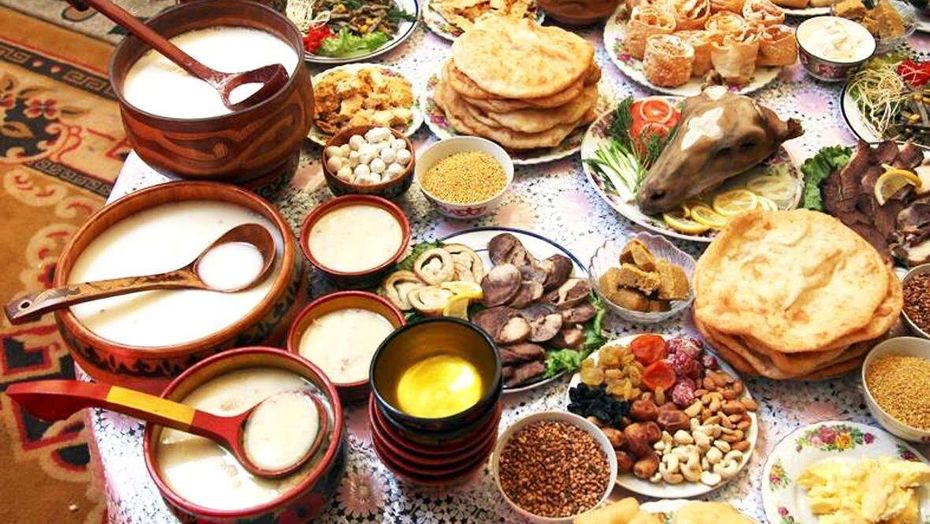
Kyrgyz Cuisine
Although you can sample Uzbek, Russian, Uighur, Dungan and other dishes in almost every part of modern Kyrgyzstan, the Kyrgyz, of course, have their own traditional cuisine. However, influenced by the nomadic past of the people, their menu is not so diverse as the ones of the peoples with sedentary heritage. There are no Kyrgyz chicken recipes, for instance, for growing poultry would have required sedentariness, but there are many traditional Kyrgyz cattle meat dishes cooked to preserve them for a long time.
Among the traditional Kyrgyz recipes stand out various horsemeat sausages. Chuchuk is probably the most outstanding of them. It is a high-fat horsemeat smoked sausage with a piquant taste. They use horsemeat for cooking a variety of other dishes, such as karyn, which is cold horse stomach slices. Very popular is beshbarmak (also spelled as beshbarmaq) - boiled and shredded meat with noodles in broth.
The Kyrgyz have long been cooking Uzbek, Tajik, Uighur and other neighboring peoples' signature dishes, such as pilaf, laghman noodles (in gravy with meat pieces and vegetables), manti and chuchpara (chuchvara) dumplings. Since the times of the Great Silk Road Central Asian nomadic and sedentary cultures, including cuisines, have always been mixing up, complementing each other.
The local people very much love and often eat honey. Honey with local flatbreads is a common morning meal in the country.
There are a lot of most delicious fruits in Kyrgyzstan in summer and autumn. The apples from Issyk-Kul Lake orchards, for instance, rank among of the world's best. When it comes to vegetables, the Kyrgyz like pumpkin very much.
What Kyrgyz cuisine is also notable for is a wide variety of fizzy fermented milk and cereal beverages. First, it is kymyz, fermented mare's milk, slightly alcoholic - the signature drink of Eurasian nomads. Very popular in the country is maksym - grounded grains, water or milk, flour, all fermented. Ayran - a mixture of fermented milk, salt and water - is also very common in Kyrgyzstan. Jarma, like maksym, is made from ground grains and mixed with ayran. Chalap is similar to ayran, and is known as Tan in the market. All these beverages are made almost everywhere in Kyrgyzstan. You can buy them from the local bazaars, stores and even at the roadsides.
Traditionally, Kyrgyz families have their meals at a dasturkhan - a large cloth spread on the floor. If you visit a Kyrgyz home, invited to dinner, you must take the food with the right hand and put your legs away from the dasturkhan. Try not to sneeze, if you can. They do not think doing so while having meals is appropriate either.
Among the traditional Kyrgyz recipes stand out various horsemeat sausages. Chuchuk is probably the most outstanding of them. It is a high-fat horsemeat smoked sausage with a piquant taste. They use horsemeat for cooking a variety of other dishes, such as karyn, which is cold horse stomach slices. Very popular is beshbarmak (also spelled as beshbarmaq) - boiled and shredded meat with noodles in broth.
The Kyrgyz have long been cooking Uzbek, Tajik, Uighur and other neighboring peoples' signature dishes, such as pilaf, laghman noodles (in gravy with meat pieces and vegetables), manti and chuchpara (chuchvara) dumplings. Since the times of the Great Silk Road Central Asian nomadic and sedentary cultures, including cuisines, have always been mixing up, complementing each other.
The local people very much love and often eat honey. Honey with local flatbreads is a common morning meal in the country.
There are a lot of most delicious fruits in Kyrgyzstan in summer and autumn. The apples from Issyk-Kul Lake orchards, for instance, rank among of the world's best. When it comes to vegetables, the Kyrgyz like pumpkin very much.
What Kyrgyz cuisine is also notable for is a wide variety of fizzy fermented milk and cereal beverages. First, it is kymyz, fermented mare's milk, slightly alcoholic - the signature drink of Eurasian nomads. Very popular in the country is maksym - grounded grains, water or milk, flour, all fermented. Ayran - a mixture of fermented milk, salt and water - is also very common in Kyrgyzstan. Jarma, like maksym, is made from ground grains and mixed with ayran. Chalap is similar to ayran, and is known as Tan in the market. All these beverages are made almost everywhere in Kyrgyzstan. You can buy them from the local bazaars, stores and even at the roadsides.
Traditionally, Kyrgyz families have their meals at a dasturkhan - a large cloth spread on the floor. If you visit a Kyrgyz home, invited to dinner, you must take the food with the right hand and put your legs away from the dasturkhan. Try not to sneeze, if you can. They do not think doing so while having meals is appropriate either.
Celestial Mountains
Land Of Celestial Mountains
It's impossible to imagine the history and culture of the Kyrgyz without Tien Shan and Pamir mountain ranges. Visit Kyrgyzstan, the land of celestial mountains, to get to know about the true nomadic lifestyle and unveil the real spirit of freedom and happiness.

Kyrgyzstan
ROOF of CENTRAL ASIA
Of the five mountains that exceed altitudes of 7000 meters in ex-USSR territories, three are found in Kyrgyzstan. The Pobeda Peak (at 7439 meters) is the highest and most difficult to climb, due to unpredictable weather conditions. The second highest peak, Lenin (at 7134 meters), on the other hand, is the most accessible. Khan Tengri (at 7010 meters) is in the world climbers' elite list, as every self-respecting mountaineer must climb this peak, at least once in their life.
Kyrgyzstan
HOME OF THE SNOW LEOPARDS
A snow leopard is a graceful, large cat that is found in the rugged mountains of Central Asia. It is not surprising that Kyrgyzstan has the second largest population of snow leopards in the world. These cats live in almost all regions of the country.
Kyrgyzstan
LARGEST WILD SHEEP
Of the animal world in Kyrgyzstan, special attention deserves to be payed to the largest species of wild sheep: the Marco Polo sheep (also known as argali). The horns of an adult argali can reach lengths of up to 190 cm and accounts for up to 13% of the animal's body weight.
Issyk-kul Lake
Untouched Nature
Pristine valleys. Crystal clear mountain lakes. Powerful mountain rivers. Rich flora and fauna embracing rare species. Discover the virgin nature of Kyrgyzstan!

Kyrgyzstan
LAKE SONG-KUL
The Song-Kul is outstanding beautiful alpine lake. It lies at an altitude of 3016 m (9895 feet) above sea level. The name translates from Kyrgyz as "the last lake".
Kyrgyzstan
LAKE ISSYK-KUL
The Issyk-Kul Lake is located in the northwestern part of Kyrgyzstan, 1600 meters above sea level. It is the second largest mountain lake in the world, after Titicaca in South America. This lake, with its slight salty water and framework of forests and mountain ranges, is a true miracle of nature.
Kyrgyzstan
MYSTERIOUS LAKE OF MERZBACHER
The Merzbacher Lake consists of two pools, one lower and one upper. Twice a year, during the summer and the winter, the lower pool that is surrounded by glacial dam fully drains into Inylchek River through sub-glacial channels and, mysteriously, fills up again.
Kyrgyzstan
AIGUL FLOWER - THE BEAUTY OF SOUTHERN KYRGYZSTAN
Aigul, meaning 'moon flower,' is a beautiful endemic flower that grows nowhere else on Earth but on the slopes of a rocky mountain called Aigul-Tash, located 17 km from the town of Batken.
Kyrgyzstan
ARSLANBOB'S WALNUT FORESTS
The Arslanbob walnut forests are located in the Arslanbob valley, 1600 meters above sea level, with an area of more than 600,000 hectares - making them the largest walnut forests in the world. A common legend says that the nuts grown in Greece had been taken from these regions by Alexander the Great.
Kyrgyzstan
EDELWEISS IN ABUNDANCE
Alpine meadows at the foot of Kyrgyzstan's celestial mountains are home to rare Edelweiss flowers, in abundant quantities. The flower was listed as an endangered species, and was subject to strict protection by many European states due to dramatic decrease in its population. Numerous legends tell the story of this humble and beautiful flower as a symbol of love, loyalty, and courage among European peoples.
Burana Tower
Great Silk Road
The current territory of Kyrgyzstan served as the main bridge on the giant trade route connecting the East and West. Some routes are still used in the country as highways. By visiting the historical sites along the route of the Great Silk Road, one can delve into the past and feel the spirit of antiquity and the middle ages.

Kyrgyzstan
SACRED SULAIMAN-TOO
The Sacred Sulaiman-Too mountain is located in the center of the city of Osh. It is the first UNESCO World Heritage Site listed from Kyrgyzstan. Some historical and theological works, written sources, and ancient manuscripts mention that 366 of the 124,000 prophets sent down by God in human history had visited this mountain. The mountain has perpetually been considered a sacred place, as evidenced by the paintings in the caves on the mountain slopes.
Kyrgyzstan
SAIMALUU-TASH - CENTRAL ASIA'S LARGEST OPEN AIR GALLERY OF PETROGLYPHS
The Saimaluu-Tash area has the largest accumulation of petroglyphs in Central Asia, comprising of about 90,000 stones. The earliest ones refer to the 3rd millennium BC (during the Neolithic and Bronze Ages). The drawings are invaluable sources of information about the day-to-day life, mentality, history, and culture of the ancient tribes of hunters, ranchers, and farmers of Central Asia. The area is included in the UNESCO World Cultural Heritage tentative list.
Kyrgyzstan
MOSQUE BUILT WITHOUT A SINGLE NAIL
The Dungan Mosque was built in 1910-1912. This particular work of architecture was created by the best masters, headed by architect Zhou Si whom Haji Ibrahim specially invited from Beijing. The local people also took part in the construction of the mosque. This one-storey wooden building was built without using a single nail.
Nomadic Traditions
Nomadic Lifestyle
The Kyrgyz have been traditionally nomadic people up until the second quarter of the 20th century. Today Kyrgyzstan is one of the few countries where a certain part of the population still practices a semi-nomadic lifestyle. Welcome to Kyrgyzstan to learn how to set up a traditional nomad's house bozui, what the taste of koumiss feels like and the process of making it, how kyrgyz nomads lived in the past and how they live on summer pastures today.

Kyrgyzstan
YURT: UNIQUE DWELLING OF THE KYRGYZ
A yurt is a unique dwelling of the Turkic nomads, made of felt and wood, and fully adapted for nomadic life. It is considered one of the most mobile dwellings in the world, as it is easily assembled and dismantled, allowing it to keep cool in summer but warm in winter. The inside of the yurt is fully functional, with the woman's side accounting for a kitchen, the man's side for keeping homeowner's stuff, and the guest's side, as guests always carry a special status in nomadic culture. Being an invention of the ancient past, the yurt is still actively used in everyday life; the traditional knowledge and skills in making the Kyrgyz and Kazakh yurts were introduced to the UNESCO Representative List of the Intangible Cultural Heritage of Humanity.
Kyrgyzstan
RISING STAR: WORLD NOMAD GAMES
The World Nomad Games are the world's only major event that gathers ethnic sports competitions and cultural values of the nomadic peoples of the world onto a single platform. The first World Nomad Games were held on September 9-14, 2014, on the shore of Kyrgyzstan's pearl Issyk-Kul Lake as athletes from 19 countries took part in them. The second World Nomad Games will again be held on the shores of Kyrgyzstan's Issyk-Kul Lake, on September 3-9, 2016. This time, representatives of more than 40 countries are expected to join the Games.
Kyrgyzstan
REAL MEN'S GAME - KOK-BORU
There are numerous traditional games the Kyrgyz people have developed and preserved for centuries. Kok-Boru, meaning 'gray wolf,' is one of them. The origin of the game dates back to ancient times. In the past, the fight over a goat carcass was not just a game, but an important training for young warriors. Hundreds of riders would take part in the game. The International Federation of Kok-Boru was created in 2001, its headquarters are located in Bishkek.
Rich Heritage
Rich Heritage
The Kyrgyz have preserved rich and diverse cultural heritage for centuries. Visit Kyrgyzstan to learn more about kyrgyz folklore, on the top of which comes the Epic of Manas, novels by famous kyrgyz writer Chyngyz Aitmatov, spectacular and entertaining national games and kyrgyz handcrafts.

Kyrgyzstan
MAGIC BEVERAGE - KYMYZ
Kymyz, or Koumiss, is a dairy beverage, obtained through fermentation of mare's milk. Doctors recommend it for the treatment of tuberculosis, gastritis, pancreatic disease, anemia, neurasthenia, and cardiovascular diseases.
Kyrgyzstan
KYRGYZ FELT
Felt is a very old material used by Eurasian nomads since ancient times. The art of felting wool in Kyrgyz culture is dated. Nowadays, this unique material has begun to live in a new way in the hands of modern Kyrgyz designers. A wide range of objects are made from fet - including ala kiyiz (a type of felt carpets) and shyrdaks, clothes, hats, various household items, beauty accessories, and toys. It is worth noting that the Kyrgyz traditional art of making shyrdak and ala-kiyiz, has been introduced to the UNESCO Representative List of the Intangible Cultural Heritage of Humanity.
Kyrgyzstan
EPIC OF MANAS
The epic of Manas is one of the greatest works of world literary heritage. This monumental epic is 20 times larger than The Iliad and The Odyssey and 2.6 times larger than the ancient Indian epic Mahabharata. The trilogy, consisting of Manas, Semetei and Seitek poems, is included in the UNESCO Intangible Cultural Heritage List.
About Kyrgyzstan

About Kyrgyzstan
- When traveling through the country, you can feel connected to nature and yearning for a simpler life.
- Kyrgyzstan, a fabulous Central Asian country, is very popular with tourists and still shows great tourism potential. It has a long and eventful history and boasts a number of unique heritage sites dating from various times, including the era of the Silk Road caravan tracks, which once ran though its today's territory; and it is of course a country of fascinating natural sites, a grandiose mountain kingdom often referred to as "Central Asian Switzerland"
- The Tien Shan system of mountain ranges covers 80% of its area, featuring the extremely high mountains Pobeda Peak (7,439m), Lenin Peak (7,134m) and Khan-Tengri Peak (6,995m). Lovers of mountaineering, trekking, downhill skiing, snowboarding and other adventure tourism activities regard Kyrgyzstan as one of the world's best vacation destinations.

General Information
Kyrgyzstan is a landlocked country in the northeast of the former Soviet Central Asia. It borders China, Kazakhstan, Tajikistan and Uzbekistan. Most of the territory is covered with the Tien Shan mountain ranges. The country's highest mountain is Pobeda Peak (7,439m; "Victory Peak" in Russian; Kyrgyz: Jengish Chokusu); the lowest parts lie at an altitude of about 400 meters. The area is 199,900 square kilometers - five times as large as Switzerland.
Population
The country's population is a little over 5.6 million. Since life is hard in the mountains, most of the people live in the valleys. The largest ethnic group are Kyrgyz. They make up 72% of the population (2013 estimate) and are spread throughout the country. The largest ethnic minorities are Uzbeks (14.5%) concentrated in the south and Russians (9.0%) living mainly in the north. There are also Dungans (1.9%), Uighurs (1.1%), Tajiks (1.1%), Kazakhs (0.7%), Ukrainians (0.5%) and other smaller ethnic minorities, including Germans.
Population
The country's population is a little over 5.6 million. Since life is hard in the mountains, most of the people live in the valleys. The largest ethnic group are Kyrgyz. They make up 72% of the population (2013 estimate) and are spread throughout the country. The largest ethnic minorities are Uzbeks (14.5%) concentrated in the south and Russians (9.0%) living mainly in the north. There are also Dungans (1.9%), Uighurs (1.1%), Tajiks (1.1%), Kazakhs (0.7%), Ukrainians (0.5%) and other smaller ethnic minorities, including Germans.

Destination Map
- On routes you will see colorful canyons, as if from films about the Wild West, and red rocks of bizarre shapes, mountains covered with dark green Tien Shan fir-trees with candles, clear sonorous rivers and green meadows, high plateaus with Mongolian landscapes and pastures on Son-Kul Lake, where nomads live.
- Most of the routes will pass through the gorges of both banks of Issyk-Kul, you will visit the most beautiful places.
- And of course, Kyrgyzstan is a nomad! Yurts, felt, herds, riders. Here you can not only see it with your own eyes, but even try a little on yourself, spending the night in a real yurt somewhere in an amazing place and chatting with these interesting people, see how they make felt or race on a horse in their nomadic games .

Climate in Kyrgyzstan
- The country's terrain and location will allow for experiencing almost all types of climate: seaside, subtropical, temperate, dry continental, and even subpolar. The temperatures vary as to region.
- In winter, it is around -8°C in the lowlands and around -27°C in the mountains.
- In summer, however, the temperature is almost the same in the highlands and lowlands - it is around +26°C, with up to +40°C around the southern city of Osh, Fergana Valley, and -10°C around the highest mountain peaks.
- The temperatures around Issyk-Kul Lake do not vary significantly by season and are quite comfortable: it is around +2°C in winter (The lake does not freeze in winter, which even its name meaning "hot lake" is indicative of.) and +18-25°C in summer.
- The precipitation varies from 2,000mm per year in the mountains to around 100mm per year on the west bank of Issyk-Kul Lake. The air in the country is mainly dry. The yearly number of sunny days is quite large - it is 247.

How to dress
- The best summer clothes to wear in the country will be T-shirts, light shirts, light and loose trousers, shorts, or sundresses. Clothes made of cotton, or having most of cotton, will feel ideal - cotton breathes and absorbs sweat better than synthetics. Do not forget that white garments will take less solar heat. However, the humidity is low in Kyrgyzstan, so high temperatures are quite bearable unless you are in the south of the country in mid-summer.
- Remember that your footwear must be comfortable, light and strong, since you will have to walk over rough ground surfaces at times. Light sandals will be great to wear in the cities. Sunglasses, light headwear and sunblock lotion should also be kept handy in summer.
- There are no dressing style limits in the local culture. However, while visiting religious sites, women should wear loose garments covering most of their arms and legs, and of course the cleavage. Headscarves will also be advisable to put on. Note that you will have to take off your shoes while entering traditional Kyrgyz homes and some of the sacred places where people pray.
- If you are planning to go to the mountains, it is quite another dressing issue. Note that it is much colder in the mountains in summer, especially at nighttime, and the weather is rather changeable up there.

Kyrgyz Cuisine
Although you can sample Uzbek, Russian, Uighur, Dungan and other dishes in almost every part of modern Kyrgyzstan, the Kyrgyz, of course, have their own traditional cuisine. However, influenced by the nomadic past of the people, their menu is not so diverse as the ones of the peoples with sedentary heritage. There are no Kyrgyz chicken recipes, for instance, for growing poultry would have required sedentariness, but there are many traditional Kyrgyz cattle meat dishes cooked to preserve them for a long time.
Among the traditional Kyrgyz recipes stand out various horsemeat sausages. Chuchuk is probably the most outstanding of them. It is a high-fat horsemeat smoked sausage with a piquant taste. They use horsemeat for cooking a variety of other dishes, such as karyn, which is cold horse stomach slices. Very popular is beshbarmak (also spelled as beshbarmaq) - boiled and shredded meat with noodles in broth.
The Kyrgyz have long been cooking Uzbek, Tajik, Uighur and other neighboring peoples' signature dishes, such as pilaf, laghman noodles (in gravy with meat pieces and vegetables), manti and chuchpara (chuchvara) dumplings. Since the times of the Great Silk Road Central Asian nomadic and sedentary cultures, including cuisines, have always been mixing up, complementing each other.
The local people very much love and often eat honey. Honey with local flatbreads is a common morning meal in the country.
There are a lot of most delicious fruits in Kyrgyzstan in summer and autumn. The apples from Issyk-Kul Lake orchards, for instance, rank among of the world's best. When it comes to vegetables, the Kyrgyz like pumpkin very much.
What Kyrgyz cuisine is also notable for is a wide variety of fizzy fermented milk and cereal beverages. First, it is kymyz, fermented mare's milk, slightly alcoholic - the signature drink of Eurasian nomads. Very popular in the country is maksym - grounded grains, water or milk, flour, all fermented. Ayran - a mixture of fermented milk, salt and water - is also very common in Kyrgyzstan. Jarma, like maksym, is made from ground grains and mixed with ayran. Chalap is similar to ayran, and is known as Tan in the market. All these beverages are made almost everywhere in Kyrgyzstan. You can buy them from the local bazaars, stores and even at the roadsides.
Traditionally, Kyrgyz families have their meals at a dasturkhan - a large cloth spread on the floor. If you visit a Kyrgyz home, invited to dinner, you must take the food with the right hand and put your legs away from the dasturkhan. Try not to sneeze, if you can. They do not think doing so while having meals is appropriate either.
Among the traditional Kyrgyz recipes stand out various horsemeat sausages. Chuchuk is probably the most outstanding of them. It is a high-fat horsemeat smoked sausage with a piquant taste. They use horsemeat for cooking a variety of other dishes, such as karyn, which is cold horse stomach slices. Very popular is beshbarmak (also spelled as beshbarmaq) - boiled and shredded meat with noodles in broth.
The Kyrgyz have long been cooking Uzbek, Tajik, Uighur and other neighboring peoples' signature dishes, such as pilaf, laghman noodles (in gravy with meat pieces and vegetables), manti and chuchpara (chuchvara) dumplings. Since the times of the Great Silk Road Central Asian nomadic and sedentary cultures, including cuisines, have always been mixing up, complementing each other.
The local people very much love and often eat honey. Honey with local flatbreads is a common morning meal in the country.
There are a lot of most delicious fruits in Kyrgyzstan in summer and autumn. The apples from Issyk-Kul Lake orchards, for instance, rank among of the world's best. When it comes to vegetables, the Kyrgyz like pumpkin very much.
What Kyrgyz cuisine is also notable for is a wide variety of fizzy fermented milk and cereal beverages. First, it is kymyz, fermented mare's milk, slightly alcoholic - the signature drink of Eurasian nomads. Very popular in the country is maksym - grounded grains, water or milk, flour, all fermented. Ayran - a mixture of fermented milk, salt and water - is also very common in Kyrgyzstan. Jarma, like maksym, is made from ground grains and mixed with ayran. Chalap is similar to ayran, and is known as Tan in the market. All these beverages are made almost everywhere in Kyrgyzstan. You can buy them from the local bazaars, stores and even at the roadsides.
Traditionally, Kyrgyz families have their meals at a dasturkhan - a large cloth spread on the floor. If you visit a Kyrgyz home, invited to dinner, you must take the food with the right hand and put your legs away from the dasturkhan. Try not to sneeze, if you can. They do not think doing so while having meals is appropriate either.




